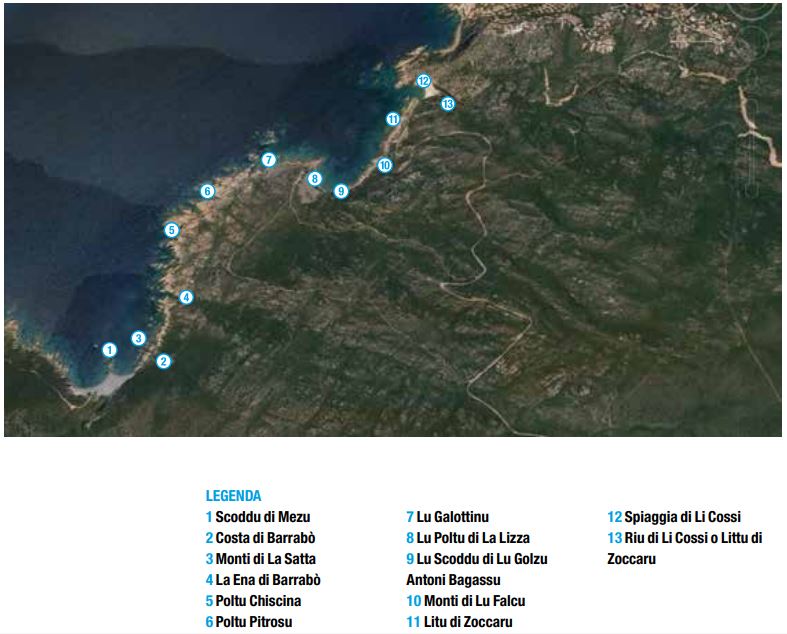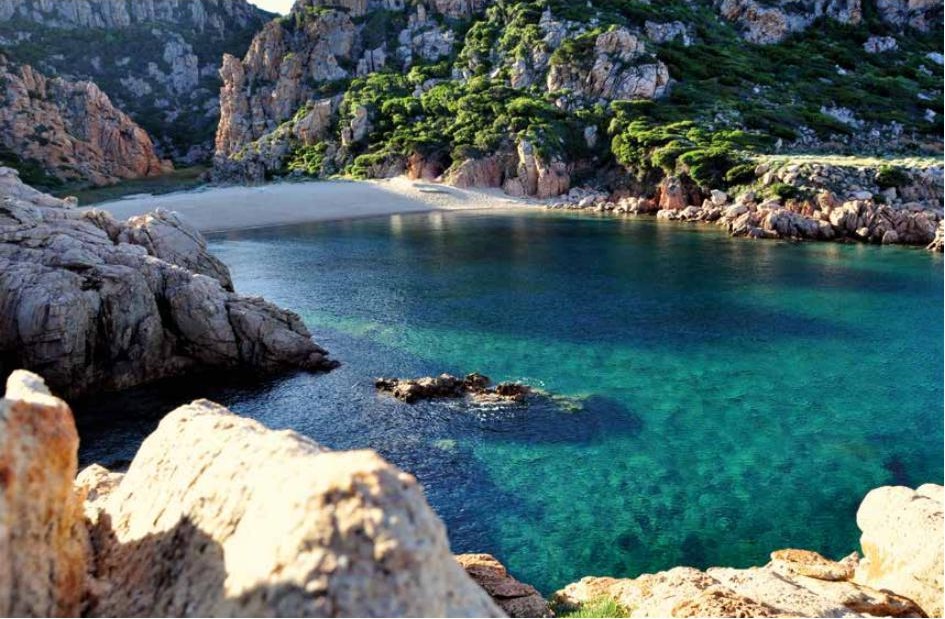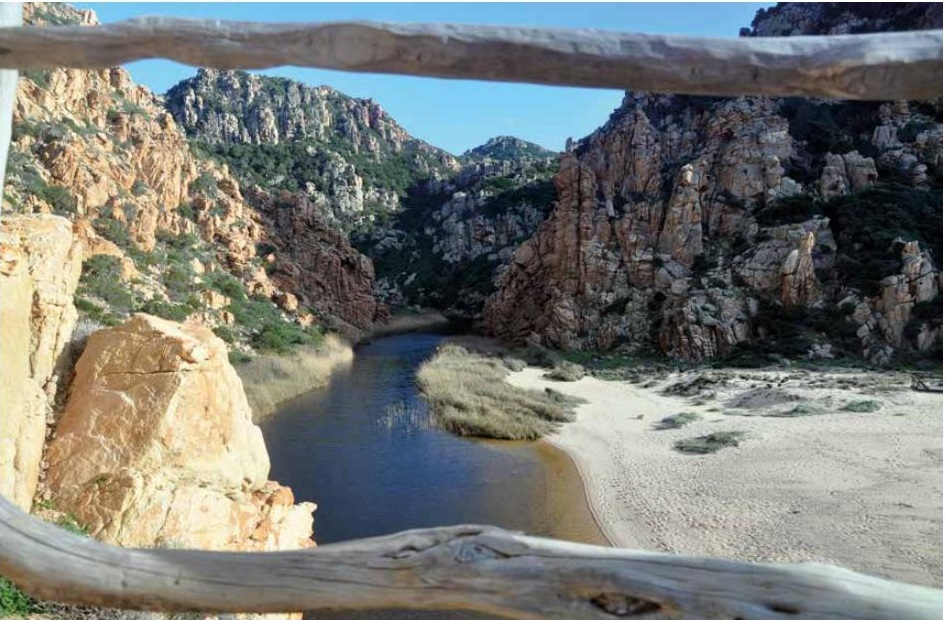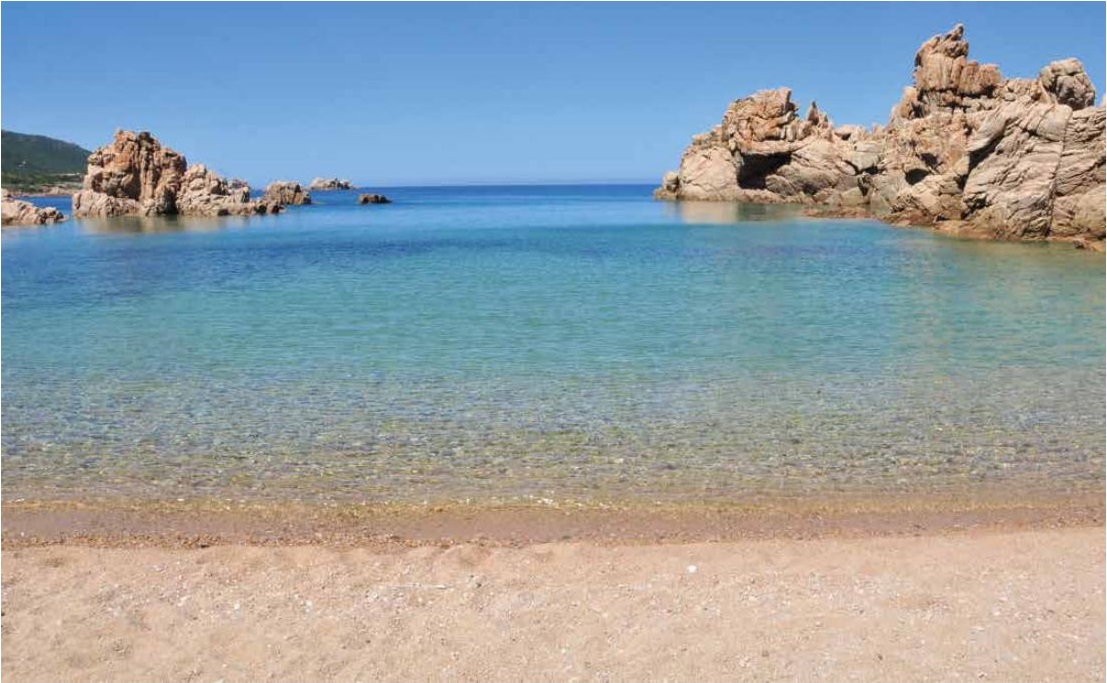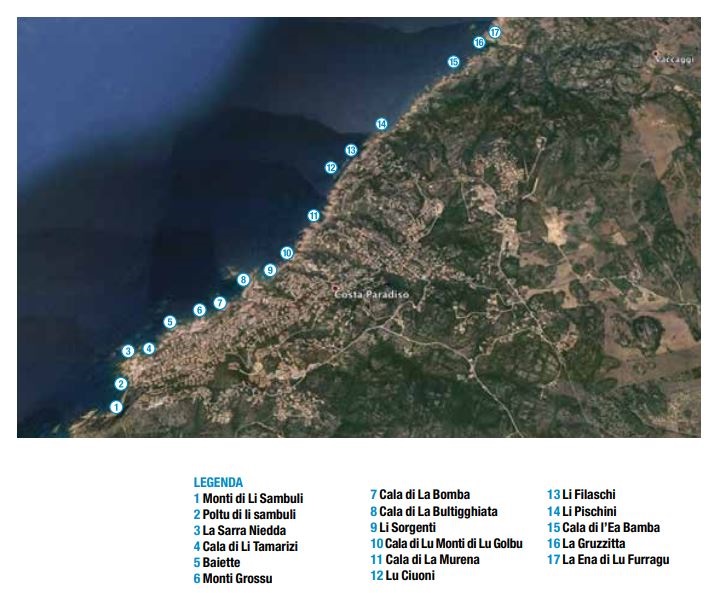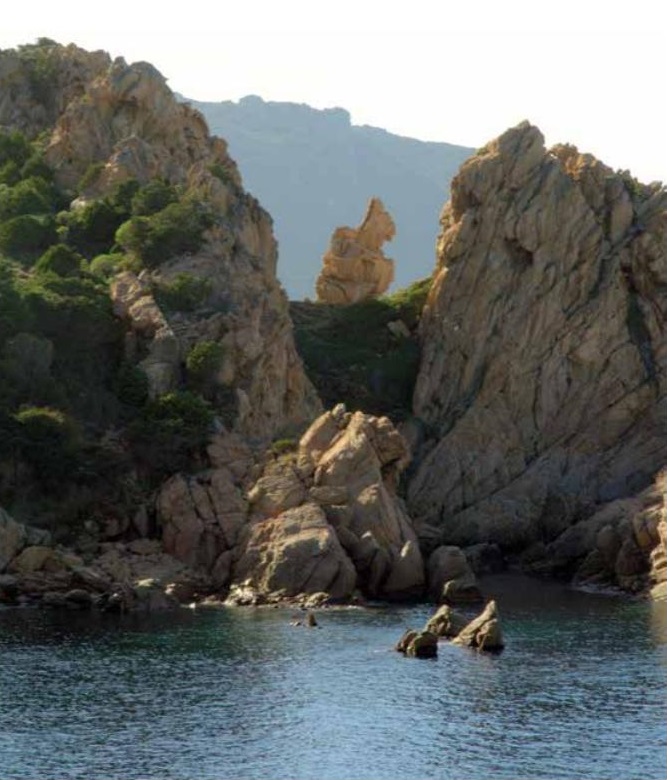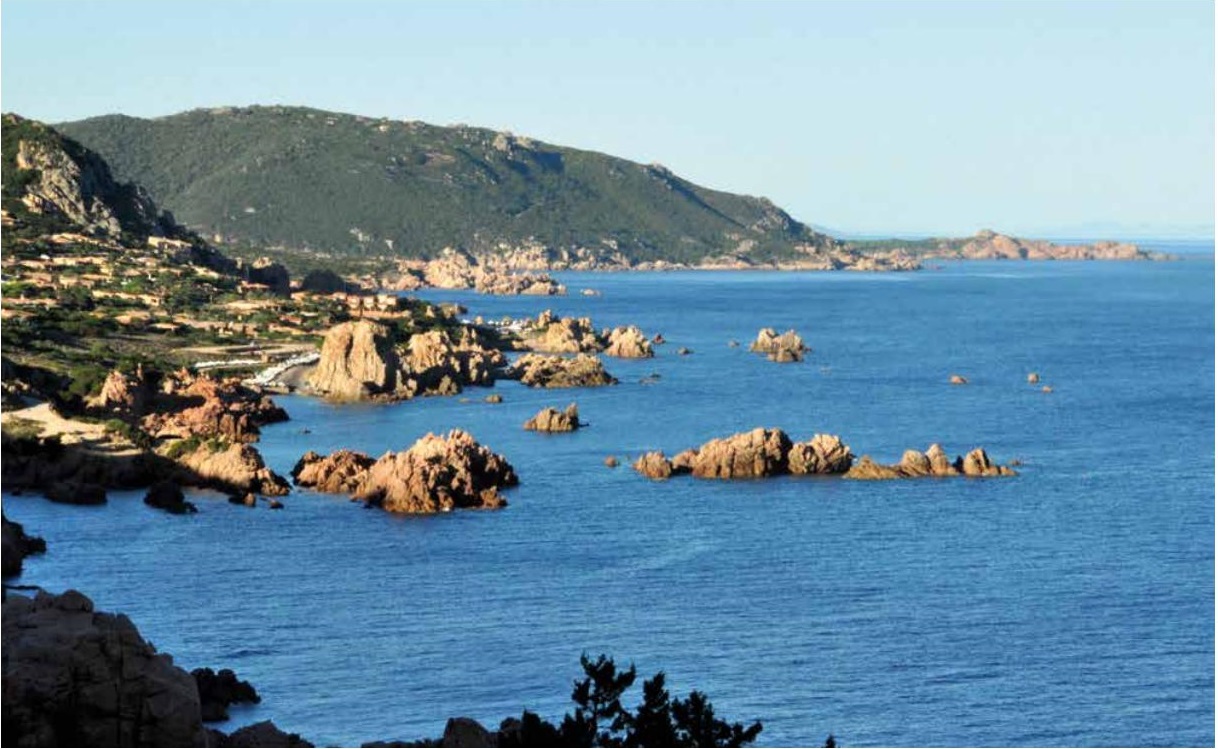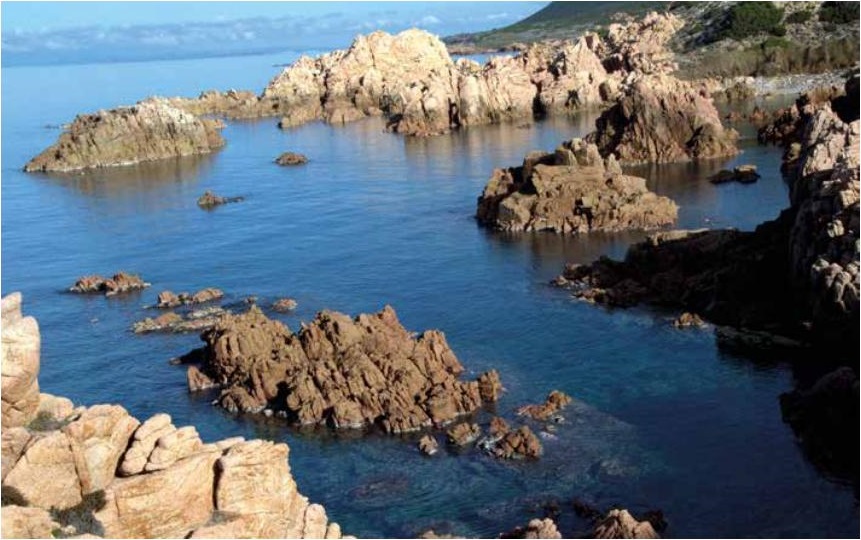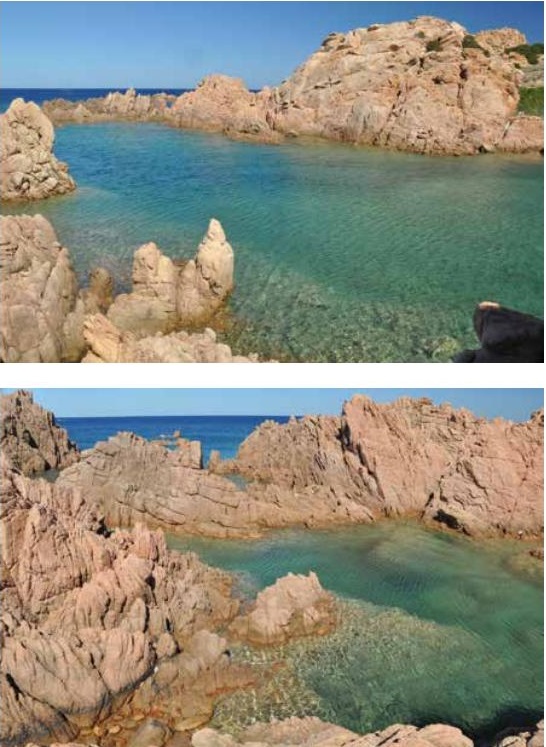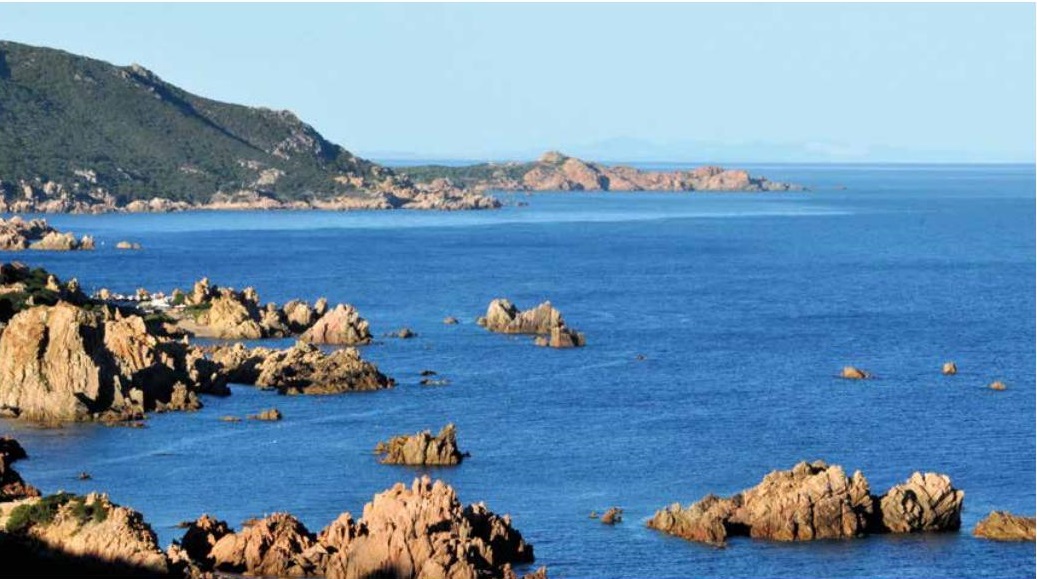TOUR COSTA PARADISO
by Mario Piga
extracts from the bookValledoria, Badesi, Trinità and Aglientu
SENTRIES OF THE GULF
From the Foce del Coghinas to Rio Vignola
Sassari, Carlo Delfino Editore, 2019 ⇒
courtesy of the Author
From TINNARI BEACH [also called Lu Stagnoni or Scoddu di Mezzu] to LI COSSI
From TINNARI BEACH [also called Lu Stagnoni or Scoddu di Mezzu] to LI COSSI
After passing this challenging stretch of coastline, you find yourself in the middle of the Mediterranean scrub, where contact releases the inebriating scent of myrtle and rosemary. Plants that thrive in places like Barrabò and La Piana di Li Zelvi (Deer Plain): a fascinating term since the toponym recalls the idea that, in other times, these lovely mammals must have resided here.
After passing the first jagged cliffs, you come to Lu Monti of La Satta (Raft Mountain) […].
Next, we come up to some tall shrubs surrounded by more Mediterranean bushes, such as the Cistus incanus (hoary rock-rose), Cistus salvifolius (Gallipoli rose) and Helichrysum saxatile moris (helichrysum). This last plant, brundedda in the local dialect, is used to “pa uscià li polchi”, that is to say, to burn a pig’s bristles after it has been killed.
This variegated flora fades into all shades of green along the way to Lu Poltu di La Lizza (holm oak haven). There, right in in the middle of the bay, stands a great holm oak tree with more surrounding it, thus giving the place its name.
The path leading to Litu di Zoccaru beach is lined by natural sculptures shaped by the salty wind over centuries of time. Among the many rocks, a pointy one is named Lu Monti di lu Colzu […].
after the nickname passed on to one Antoni Bagassu-Doro by his mother Malu-Bagassu. The man had gone to that place to gather limpets but fell in the water and drowned in the waves.
Between the coastal bends, penguin, greyhound and turtle head shaped rocks suddenly appear like sentinels on our path. Up on top, a sleepy wise man lies on the adjacent cliff in plain view. From his privileged position, he seems to point the way to this breathtaking stretch of coastline, inviting us to continue. Next, the beauty of a narrowing reveals a rose-coloured sandy beach nestled by a river flowing out of a deep, steep canyon.
This is Li Cossi beach, named after the river, famous for its unique beauty as well as having been the setting of some scenes from the motion picture “Black Stallion”.
Filled with poetic images and the fascination of the place, this film tells the story of a friendship between a shipwrecked young man and his horse.
DA LI COSSI A LA CRUZITTA
From Li Cossi to La Cruzitta
After the beach are steep stone steps climbing up the rocks; from up there, one cannot help admiring the natural beauty of yet another gulf. This path is set between rocky cliffs looking straight down to the sea, interspersed with natural shapes and figures carved by the wind and salt; resembling cartoon characters, like Goofy’s snout, or sculptures, like Michelangelo’s Pietà, they are surrounded by juniper branches twisted by the wind.
Behind them stands Lu Monti di li Sambuli (wild garlic mountain), where lush edible wild garlic grows (sambula in the local dialect, Allium triquetrum in Latin); we loved it as children when we would have it on bread at picnics. This kind of garlic is very common in the hills but less so near the sea, unlike Li Rosi Marini (sea roses), which is also the name of the bay at the foot of the neighbouring steps.
At the end of the steps starts a piece of the coastline formerly called La Sarra Niedda (Black Resegone). In this arid and dry stretch of land, nature has indulged itself in all its primordial magnificence by giving us a wonderful seascape, but even more so by chiselling unique granitic statues with the help of the mistral.
Visionary Milanese businessman Mr Tizzoni discovered it and renamed it COSTA PARADISO. Although many had called it “Hell” because hard to get to, its original name is written even in a “muttetto” (popular poem from Aggius), which reads as follows, “Vistu agghiu a bedda stedda and fattu ma lu sorrisu , primma was the Sarra Niedda abà is Costa Paradisu” (I saw a beautiful young lady who smiled at me, she used to be the Black Resegone, but now she is Paradise Coast). According to our ancestors, only wild boars and goats would manage to graze here, due to the extremely dense Mediterranean vegetation, which may be why it seemed more like hell than paradise, that and its mountainous nature. […]
Walking along the cliff, between sharp rocks and coves, one feels like stopping at each tip to admire ever-changing fascinating landscapes. When you get to Cala di li Tamarizi (cove of the tamarisk, a very wide-spread local coastal plant), you can’t help but take a break and dive into its crystal-clear water.
After a refreshing bath, continue through the Baiette (small bays) and the small port of Monti Grossu (big mountain), up to Cala di la Bomba (bomb cove). Here, a very long time ago, a weapon of war exploded against the rocks.
The adjacent Cala di la Bultigghiata (sea anemone cove) was once abundant with this delicious seafood, nowadays unfortunately all but vanished.
Baia delle Sorgenti (spring bay) leads to a climb along the border, right by the mansion of famous director Michelangelo Antonioni. This Costa Paradiso border attraction should be better promoted to entice tourists from all over the world.
Walking along a side path overlooking the mansion, one comes across a centuries-old forest of tamarisks and junipers, surrounded by myrtle, arbutus and tree heather, ending up on a breathtaking cliff surrounded by clear, luminous green water. This coastline path that leads to Lu Poltu di la Cruzitta (little cross haven) is rich with surprising fauna and flora. […]
Interspersed with rocky figures and twisted juniper roots against the background of a blue-green sea, expanses of rosemary lead on to Cala di lu Monti di lu Colbu (raven mountain cove), where ravens found shelter since ancient times but are now also almost extinct. Unlike crows, who have become omnivorous, ravens remained carnivorous and thus failed to adapt. Restrictive laws on the transfer of animal carcasses did the rest. Just ahead, Cala di la Murena (moray cove) was once the scene of an exceptional and delicious catch. Then starts a strip of coastline named Lu Ciuoni that borders Li Filaschi, a place of springs and marsh plants. We come then to fresh water, a major resource for our coasts, emphasized in the form of Cala di L’Ea Bamba (freshwater cove).
From on up, we glimpse Punta di la Cruzitta (little cross point), whose name commemorates men who lost their lives there during a revolution against the Savoy government.
These were popular riots that ended up tragically due to the Sardinians themselves, who spied on and betrayed each other. Despite rumours of danger, Sanna Corda departed from Ajaccio, Corsica, on 11 June 1802 along with some mates of his: Francesco Cilocco, Luigi Martinetti, Salvatore Loriga, all of them Sardinian emigrants, and the Corsican Biagio Fouché. It was the morning of June 13 when they landed at Little Cross Beach, in the region of Aggius.
Strategic support was provided by shepherd Matteo Codimuzzu’s stone brick dwelling, where meetings had previously been held between some emissaries of theirs and Gallura shepherds in order to popularize the expedition and add to their numbers. The shepherd’s dwelling was set as the general headquarters. From there, Sanna Corda sent messages and issued chain of command assignments to Bonorva, Torralba and Aggius, where there were men ready for revolutionary action, which was ill-fated and came to a bloody end.
Photos by Mario Piga
© RIPRODUZIONE RISERVATA

